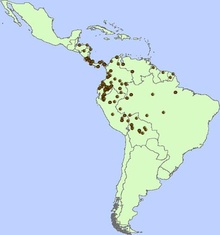| Bactris gasipaes | |
|---|---|

| |
| Scientific classification | |
| Kingdom: | Plantae |
| Clade: | Tracheophytes |
| Clade: | Angiosperms |
| Clade: | Monocots |
| Clade: | Commelinids |
| Order: | Arecales |
| Family: | Arecaceae |
| Genus: | Bactris |
| Species: | B. gasipaes
|
| Binomial name | |
| Bactris gasipaes | |

| |
| Distribution of Bactris gasipaes. | |
| Synonyms[2] | |
|
Guilielma gasipaes (Kunth) L.H.Bailey | |
Bactris gasipaes is a species of palm native to the tropical forests of Central and South America. It is well spread in these regions, where it is often cultivated by smallholders in agroforestry systems or more rarely, in monoculture. Common names include peach palm in English, among others used in South American countries. It is a long-lived perennial plant that is productive for 50 to 75 years on average. Its population has an important genetic diversity, leading to numerous fruits, colors, and qualities. The fruits are edible and nutritious but need to be cooked for 30 minutes to five hours. They also benefit many animals in the wild. Peach-palms are also cultivated for the heart of palm, and the trunk can make valuable timber.[3]
- ^ Hernández Bermejo, J. E. and J. León, Eds. Peach-palm (Bactris gasipaes). In: Neglected Crops: 1492 From a Different Perspective. Rome: UN FAO. 1994. ISBN 92-5-103217-3
- ^ "Bactris gasipaes Kunth". Plants of the World Online. Board of Trustees of the Royal Botanic Gardens, Kew. 2017. Retrieved 4 December 2020.
- ^ Graefe, Sophie (2013). "Peach palm (Bactris gasipaes) in tropical Latin America: implications for biodiversity conservation, natural resource management and human nutrition". Biodiversity and Conservation. 22 (2): 269–300. Bibcode:2013BiCon..22..269G. doi:10.1007/s10531-012-0402-3.